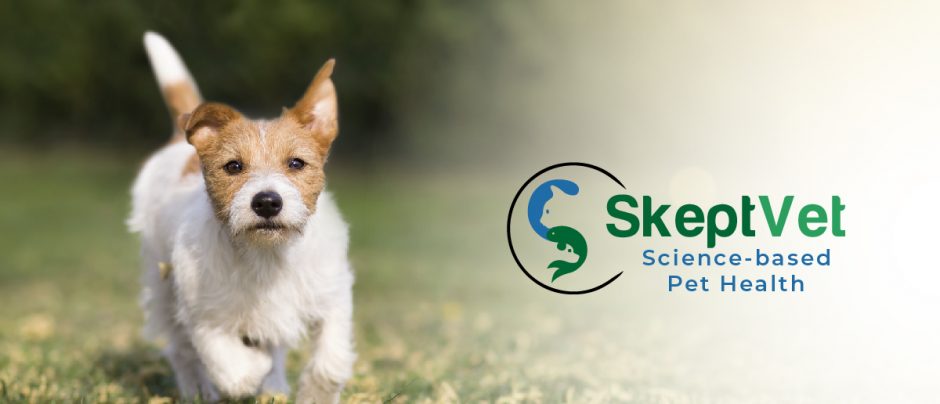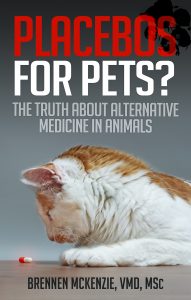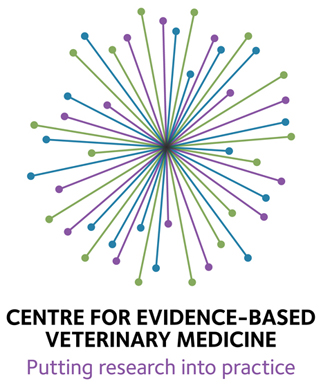Most pet owners understand that science-based medicine is the best hope for maintaining and restoring health in their animal companions. The tremendous successes of preventative and therapeutic healthcare in the last couple of centuries is difficult to deny (though proponents of alternative medicine certainly try).
While there are plenty of obvious and dramatic successes for specific interventions, like vaccination and antibiotics, the real power of science-based medicine is in the use of systematic methods for learning about how nature works, and how disease comes about. A true understanding of how our bodies work and what goes wrong in illness is more likely to lead to effective disease prevention and treatment than an elaborate set of myths and metaphors with little connection to the reality of nature.
Unfortunately, it is all too easy to find such myth-based systems, applying treatments in complex and ritualized ways without doing the hard and important work of scientific investigations to evaluate the truth behind their systems or the real effects of their interventions. I’ve addressed the bizarre pseudoscientific theories of homeopathy and the pre-scientific mythos of so-called Traditional Chinese Veterinary Medicine here before.
Such approaches may seem at best quaint and anachronistic, at worst deluded, but for the most part even people who understand the value and importance of science and science-based medicine tend to view them as harmless. However, false beliefs about nature that are used to construct systems of medical treatment and aggressively marketed can be harmful, both directly and indirectly. Even a system like homeopathy, which ultimately sells only magic water as medicine, can cause harm when it is applied to serious illness and used to discourage or even supplant appropriate medical care.
A recent issue of the Integrative Veterinary Care Journal (IVC) devoted to alternative therapies for cancer illustrates the danger of such misguided approaches. Two articles, in particular, discussing naturopathic and homeopathic cancer treatment, reveal some of the core beliefs of these practitioners who, despite their talk of “complementing” conventional medicine, really have a view of health and disease incompatible with and deeply opposed to that of science:
- Health and disease are as much spiritual issues as they are questions about physical health.
- Conventional medicine is fundamentally mistaken in its understanding and less effective in its treatments than alternative therapies, and it is always harmful even when it seems to be helping.
- Alternative therapies can effect cures where conventional treatment cannot, and no scientific research is needed to prove this claim
It is easy to see how such beliefs and claims could be attractive to someone facing the frightening diagnosis of cancer in their beloved animal companion. It is also, hopefully, equally obvious that when such claims are untrue, they can do harm by leading vulnerable and desperate pet owners to make poor choices in the care of their pets. Despite the appeal of the marketing language used to promote such practices, if they are based on faulty understanding and their effectiveness is unproven or non-existent, then choosing these approaches when our pets are ill is not likely to benefit, and at least as likely to harm, the pets we want so much to help.
The first article describes a “naturopathic” approach to cancer treatment.
Fougere, B. Naturopathic oncology. IVC. Winter 2104/2015. 20-23.
Naturopathy is a rather vaguely defined approach to health that incorporates virtually every alternative therapy, from acupuncture to herbs and dietary supplements, from chiropractic to homeopathy and “energy medicine.” It even includes many perfectly conventional practices such as nutrition and exercise, which it disingenuously claims to be “alternative” therapies. Naturopathy is characterized mostly by a reverence for the concept of “natural,” despite the misleading and largely illusory nature of this term. Naturopaths decide, somewhat arbitrarily, which therapies are “natural” and which aren’t and then claim to prevent and treat disease by using natural therapies to support the body’s own defenses and healing abilities. A lovely concept if there were much evidence to suggest it was true, but for the most part there is not.
In this article, Dr. Fougere makes it clear that she believes naturopathy to be safer and more effective than conventional medicine, and she clearly illustrates her belief that the scientific understanding of disease is mistaken and irrelevant to naturopathic treatment.
The greatest joy of being involved in naturopathic oncology is that our toolbox is so much larger than the one other veterinarians draw upon. It is empowering to know that there is always something more than can be done to help our patients, and even more phenomenal to be able to improve their health well beyond expectations, and create “spontaneous remissions”—something that the veterinary paradigm says is impossible…
The notion that there is never a situation in which further treatment is not in the best interests of a patient is a significant cause of great suffering, in human and veterinary medicine. While we all want to have hope, and while unexpected positive outcomes can sometimes occur, it is naïve to believe that there are never situations in which continued treatment does more harm than good. Of course, Dr. Fougere would respond that this only applies to conventional treatment, since alternative therapies can magically have only benefits and no risks.
We emphasize therapies that are non-invasive and natural and that do not make our patients less well.
Such a claim has never been proven true when examined in the objective light of science. It flies in the face of the clear evidence that one does not get something for nothing in nature. When working with a system as complex and interconnected as a living organism, it is impossible to alter one aspect as we wish without unintentionally affecting other aspects, sometimes with undesired results. The only therapies with no side-effects are therapies with no effects.
But such facts don’t disturb Dr. Fougere, who makes it clear she has little use for the understanding of health and disease produced by science, regardless of how successfully it has improved all our lives.
The diagnosis of cancer is important, but the definitive diagnosis is not central to our approach…We need to address all aspects of health and well-being, including physical factors…environmental factors, spiritual aspects, and even genetic factors.
She claims her treatments go beyond the physical health of her patients and affect their spiritual health as well. Such claims are easy to make as they cannot be proven or disproven, only accepted or rejected on faith. This also makes them of little value, since accepting any one such claim means we must rationally accept them all, stripping us of any ability to tell true from false.
Such approaches to understanding the world are natural to human beings, and they have been employed since before written history. They also did almost nothing to improve our health and longevity in thousands of years, whereas a science-based approach has had clear and unprecedented benefits. There is a cost to such beliefs, as appealing as they may be, because they lead us to acting on claims that can never be meaningfully evaluated as true or false.
Dr. Fougere’s rejection of the scientific view of cancer goes beyond simply rejecting the value of specific diagnoses. She substitutes a common, and false, alternative theory of disease.
From a naturopathic perspective, cancer arises from an imbalance or accumulation of toxicity…
Such a view of disease as caused by vague “toxins” is a reincarnation of the evil humours and it exaggerates, distorts, and ignores real scientific understanding of environmental risk factors for disease. Such toxins are claimed to be everywhere, from our food, air, and water to the very medical therapies supposed to protect and heal us, such as vaccines and medicines. The lack of specificity and evidence makes such claims about disease being caused by toxins no different than claims about disease being caused by evil spirits and demonic possession. Once again, actually finding the toxins, proving they cause disease, and testing if and how one’s treatments restore health are all irrelevant. This is faith-based medicine at its finest.
Most of the specific therapies Dr. Fougere recommends have little to no evidence to show they benefit cancer patients. They often have mutually incompatible theories behind their supposed effects, which are conveniently ignores, and they are often illustrations of the anti-scientific world view underlying the whole practice of naturopathy. A few examples:
We use [acupuncture] routinely to enhance energy and well-being. [whatever these might be and however acupuncture might enhance them, all without any risk, of course]
Ideally, herbs are prescribed according to the patient’s vitality, energetics, symptoms, concurrent treatments, prognosis, and diagnosis. [the order in which these factors are listed is interesting, with anything objective or scientifically established last and anything subjective and immeasurable given greater importance.]
Detoxification is an herbal medicine principle in cancer treatment, because cancer is thought to be the end result of accumulated toxins in the body.
Herbs with antioxidant effects can reduce the side effects of chemotherapy and radiation….[There is, naturally, no mention of the fact that antioxidants can also reduce the effectiveness of chemotherapy (e.g. 1, 2) and even increase cancer risk. The myth that such things can only be beneficial and must be safe because they are “natural” is a dangerous one.]
Another article in the same issue makes similar, and even more absurd, claims:
Stieg, S. Homeopathy for cancer: A gentle approach to a cure. IVC. Winter 2104/2015. 52-55.
Given the overwhelming evidence that homeopathy is only a placebo, the very suggestion that it could be used to treat, even cure, cancer is so at odds with reality it is difficult to see how it is not malpractice. There is really no way such a therapy can benefit the patient, even though the therapeutic ritual might comfort an owner. And belief in such a patently false view of health and disease, which leads one away from the proper use of science-based diagnostic and therapeutic methods, is only going to lead to harm. Yet Dr. Stieg blithely suggests this nonsense is safer and more effective than conventional medicine.
Homeopathy…offers a gentle approach to cancer, treating not just the lesion or condition but the patient as a whole. General well-being is first restored while the cancerous condition is being abated or resolved, and is followed by a return of good health….It is a good alternative to an allopathic approach.
Armed with this delusion that homeopathy is actually an effective alternative to real cancer treatment, Dr. Stieg gives further examples of her complete dismissal of the entire basis of modern, scientific medicine.
While allopathic nomenclature may be helpful in understanding a clinical situation, general disease labels are not needed to find an accurate prescription in homeopathy since they do not describe what is unique to an individual patient.
In other words, homeopaths don’t care what your actual diagnosis or disease is. They choose their therapies, as we have seen, based on arbitrary factors on questionable relevance, like what kind of dreams you’ve been having, what time of day you feel worst, and so on. Knowing you have a particular cancer does not, apparently, help them decide how to treat you, but these sorts of extraneous personal details do.
The hubris displayed, in claiming clear superiority in goals, safety, and effectiveness over real medicine despite the extensive evidence to the contrary only adds to the clear message here: anyone trusting their animal companion to this sort of treatment is being dangerously misled.
Homeopathic treatment aims to cure the patient and have the cancer completely resolve, without causing harmful side effects or requiring repeated medication…The case studies accompanying this article demonstrate how the homeopathic treatment of cancer successfully returned the patients to health and provided an increased quality of life without surgery, chemotherapy, or harmful side effects.
Apart from the generally unreliable nature of anecdotes, one imagines it should be fairly easy to find examples of patients with cancers that resolved complete under homeopathic treatment since homeopaths don’t find “allopathic” diagnosis relevant or necessary and so may well not bothering confirming it before proceeding with treatment. I once had a client whose young, asymptomatic dog was diagnosed annually with some dire illness, often cancer, which I could never identify. Each time, this illness which could only be seen by the homeopath was also magically cured, all without a single outward symptom of illness. Miraculous indeed!
Conclusion
It sometimes difficult not to find such articles amusing in their clear lack of connection to reality. Yet they are actually more tragic than funny, because unfortunately they fool people into believing the practices discussed have real value. The majority of the specific therapies are untested, and the general approach flies in the face of established science.
This is not to say there cannot be any benefit from any of the specific therapies. Some of the things naturopaths recommend, such as a healthy diet and exercise, are certainly beneficial. However, there is also nothing “alternative” about these practices, and they are regularly recommended by science-based clinicians as well. Other therapies, such as herbal remedies, may well have benefits, but these are almost always unproven. What is crucial is that those which do have benefits will also have risks, and these are as unknown as any potential benefits without proper scientific study. And many of the therapies recommended, such as homeopathy and “energy” therapies, are patently useless.
The key problem is that using therapies with unproven or no benefits and unknown risks guided by pseudoscientific notions of how health and disease work, especially in place of therapies based on a sound scientific understanding of disease and for which the benefits and risks are well-established, exposes patients to unnecessary harm. Such an approach had better be capable of performing miracles because only a miracle, a special suspension of the natural laws that govern the physical world, could make such an approach more likely to help than to harm the patient. Unfortunately, humans relied on such approaches for most of our history, with terrible results. Science has more than proven that while it is flawed and imperfect, as all human endeavors are, it is a far better choice for us and for our pets.











